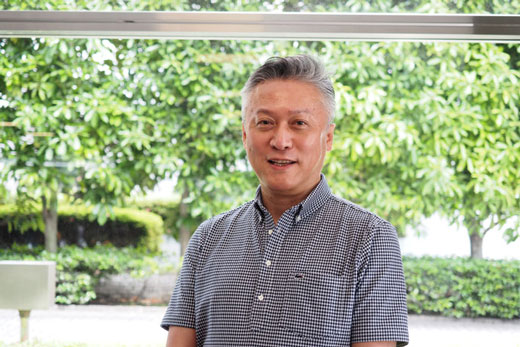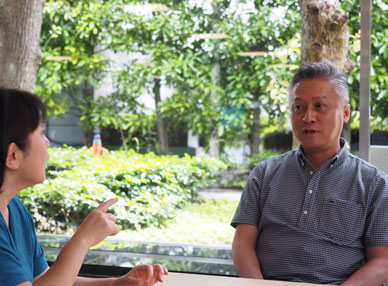About Risk Management
Building a risk management system that will allow the newly integrated company to be a company that can compete on the world stage by making appropriate responses to changes in the business environment

Tomotaka Tsutsuzaki
Manager, Preparation Office for Risk Management Department, Showa Denko K.K.
Risk management means to manage risks posed to business management so as to avoid them and reduce their impact on the organization, including related loss. Recently, the environment surrounding companies has been constantly changing due to factors such as climate change, COVID-19 and the situation in Ukraine. Accordingly, the importance of risk management is increasing. Under these circumstances the Showa Denko Group is implementing measures for risk management and has set a vision for the type of risk management to be pursued by the newly integrated company. In the following, Tomotaka Tsutsuzaki from the Preparation Office for Risk Management Department provides an outline. (The dialogue was held in a former Showa Denko conference room on June 1, 2022.)
1. Present job duties
We need to manage risks on the presumption that we cannot reduce risks posed to corporate activities to zero. Based on this recognition, it is important to work to detect and identify risks and prepare against their materialization while implementing preventive measures. Risks mean anything that causes a change to business management, and both negative and positive factors could pose risks to us. For example, if a certain product becomes very popular in the market, we might run out of stock, which could inconvenience customers and result in our losing business opportunities. The risks that we should address might also change due to changes in the external environment, such as climate change, social change and major global trends, including the moves made by national governments, the United Nations and others.
2. About the KPIs set for risk management based on the sustainability-related material issues (materiality)
The KPIs set for risk management based on the sustainability-related material issues (materiality)
Prioritization of the KPIs set for risk management
We aim to reinforce our system for managing increasingly diverse and complex risks. The Risk Management Committee examines the findings of risks assessments, including operational, hazard and strategy risks. However, the number of risks is large—more than 3,000—and we therefore classify them based on their frequency and the magnitude of impact to identify important risks and those to be prioritized. We regard risks that are classified as “Very High” and “High” as “top risks,” for which we examine possible events and countermeasures with the related departments, share the results with them and also report the results to the Management Committee. We are thereby building a system for the management team to be informed of serious risks that could badly affect the Showa Denko Group's business management for the continuous and appropriate monitoring and supervision of the related measures by top management. In 2022, we started to implement measures to expand our risk identification and assessment system on a global scale and enhance the functions of the risk supervising department. We have been also considering the multilingualization of the system. Through these efforts we will achieve effective risk management. I also think it is necessary for the management team to keep in mind the requirements to be met by a company that can compete on the world stage.
Importance of raising awareness of risk management
We will provide level-specific education to help directors and officers, departmental and sectional managers, and general employees to deepen their understanding of the importance of risk management. We will also appoint a “risk owner,” “risk officer” or “risk manager” at each of the departments and job ranks to establish an autonomous risk control system and implement risk reduction measures. The risk owner, risk officer and risk manager will share with departmental and sectional staff their knowledge about risk management, including the risk-related mega trends and the fact that risk management is interrelated with corporate value. We will thereby raise awareness of risk management across the board. Moreover, we will also provide employees working at manufacturing facilities with relevant education and training to help them sharpen their sensitivity to risks and gain more understanding about risks. It is essential to increase the number of employees who can talk to each other about risk management based on a shared understanding of risk management as a challenge to be met by the whole Group.

There are a range of issues regarding strategy, operational and hazard risks, and it would be difficult for a single department to deal with all of them. How could these risks be managed?
All the departments are given access to the risk assessment system for the registration of data with the system. However, the department in charge of strategy risks tends to focus on strategy risks within the department while the sites and business divisions tend to focus on operational and hazard risks. In order to manage the identified risks as an organization, we need to establish a system for the relevant departments to collaborate for the comprehensive management of the risks. It is important for the department in charge of strategy risks, our risk management department, and the business divisions to cooperate with one another for the establishment of a company-wide risk management cycle.
For example, it is difficult to assess the specific impact of a risk that might arise from making an investment in a business unless the size of the investment is clarified at the business planning stage. It is therefore important for the business planning unit to identify the risk and then share the information with related divisions and departments. We need to establish this kind of comprehensive risk information sharing system. To this end, we will hold a meeting of related departments so that they can exchange opinions about the desirable strategy risk management cycle.
Enhancement of the second defense line function for internal control
For risk management, the self-cleansing function of the departments engaged in daily business operations is very important as the first line of defense. I think it is ideal that the risks are eliminated by this first line before they become an issue. However, if the business departments fail to identify their operational risks, the administrative departments will serve as the second line of defense by monitoring how risks that are placed under their control are handled by the business departments and issuing warnings and advice to the departments as necessary. Furthermore, the Internal Audit Department will serve as the third and last line of defense. This, however, is still not sufficient for comprehensive risk monitoring. We at the risk management department will therefore monitor the risks in a comprehensive and exhaustive manner and check whether or not the administrative departments are appropriately monitoring the risks posed to the manufacturing sites and business units as the second line of defense. Then, if we detect a problem, we will share it through the Risk Management Committee, thereby improving and enhancing our risk management.
Selection of important products and formulation of BCPs
As a challenge to be met for business continuity plans (BCPs), we need to confirm the safety of employees and their families in the event of an emergency, such as a large earthquake. As a manufacturer, we also need to fulfill our supplier responsibilities to our customers. If our manufacturing facilities are suspended due to a disaster, we will supply the affected products from inventory, and in preparation against such a case, we need to decide on the measures and approach to be taken when the products are finally out of stock. In the past, the divisions were tasked with this kind of decision-making, but now we need to conduct discussions more widely on what our important products are and set the prioritization criteria for such products across the board. Moreover, we need to verify the effectiveness of the BCPs set by each division, site and Group company, provide them with regular simulation training for the updating of their plans, and share with them training details, identified challenges and best practices for the improvement of their respective BCPs. The newly integrated company will have a new risk management department with a larger dedicated staff. The department will implement measures from various viewpoints and execute the risk management cycle accordingly.
3. Comments about and commitment to risk management
There is no end to risk management. Targeting not only operational and hazard risks but also strategy risks, we will involve all departments, sites and on-site employees in our effort to improve the risk management level of the entire Group by steadily implementing the “risk inventory” activity and providing BCP-related training.
